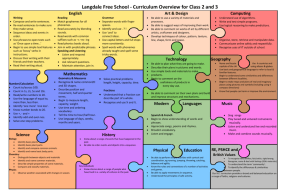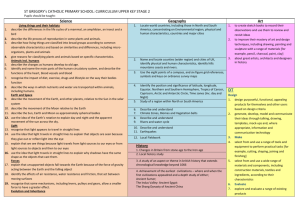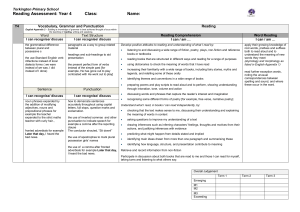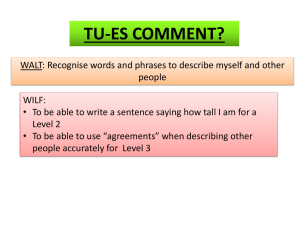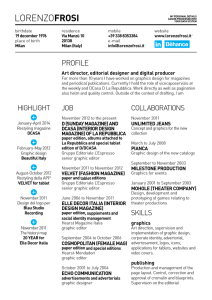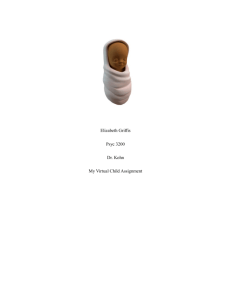Assessment Ladder Fr - Nov 2014
advertisement
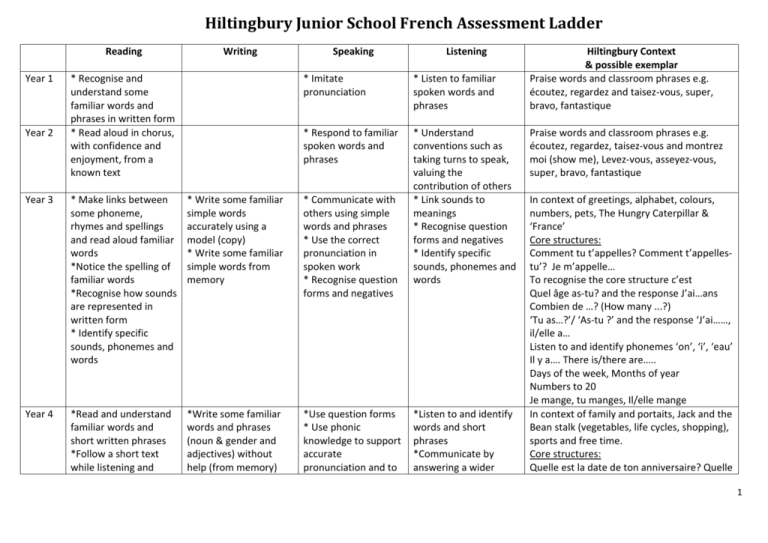
Hiltingbury Junior School French Assessment Ladder Reading Year 1 Year 2 Writing * Recognise and understand some familiar words and phrases in written form * Read aloud in chorus, with confidence and enjoyment, from a known text Speaking Listening * Imitate pronunciation * Listen to familiar spoken words and phrases * Respond to familiar spoken words and phrases * Understand conventions such as taking turns to speak, valuing the contribution of others * Link sounds to meanings * Recognise question forms and negatives * Identify specific sounds, phonemes and words Year 3 * Make links between some phoneme, rhymes and spellings and read aloud familiar words *Notice the spelling of familiar words *Recognise how sounds are represented in written form * Identify specific sounds, phonemes and words * Write some familiar simple words accurately using a model (copy) * Write some familiar simple words from memory * Communicate with others using simple words and phrases * Use the correct pronunciation in spoken work * Recognise question forms and negatives Year 4 *Read and understand familiar words and short written phrases *Follow a short text while listening and *Write some familiar words and phrases (noun & gender and adjectives) without help (from memory) *Use question forms * Use phonic knowledge to support accurate pronunciation and to *Listen to and identify words and short phrases *Communicate by answering a wider Hiltingbury Context & possible exemplar Praise words and classroom phrases e.g. écoutez, regardez and taisez-vous, super, bravo, fantastique Praise words and classroom phrases e.g. écoutez, regardez, taisez-vous and montrez moi (show me), Levez-vous, asseyez-vous, super, bravo, fantastique In context of greetings, alphabet, colours, numbers, pets, The Hungry Caterpillar & ‘France’ Core structures: Comment tu t’appelles? Comment t’appellestu’? Je m’appelle… To recognise the core structure c’est Quel âge as-tu? and the response J’ai…ans Combien de …? (How many ...?) ‘Tu as…?’/ ‘As-tu ?’ and the response ‘J’ai……, il/elle a… Listen to and identify phonemes ‘on’, ‘i’, ‘eau’ Il y a…. There is/there are….. Days of the week, Months of year Numbers to 20 Je mange, tu manges, Il/elle mange In context of family and portaits, Jack and the Bean stalk (vegetables, life cycles, shopping), sports and free time. Core structures: Quelle est la date de ton anniversaire? Quelle 1 Year 5 reading, saying some of the text *Read a wider range of words, phrases and sentences aloud *Apply phonic knowledge to decode text *Recognise and apply simple agreements (e.g. gender, plural, singular) *Recognise negative statements *Recognise categories of words (e.g. colours) and word classes *Copying simple structures *Use question forms * Use phonic knowledge to support accurate pronunciation and to write simple words and phrases *Recognise and apply simple agreements (e.g. gender, plural, singular) say simple words and phrases range of questions *Sort words according to sounds *Recognise negative statements *Recognise categories of words (e.g. colours) and word classes *Read and understand some of the main points from a short text *Recognise typical conventions of word order and compare with English *Understand and use negative statements *Understand how a simple sentence is written *Write words, phrases and a few sentences using a model *Remembering simple structures and applying in new contexts *Joining simple sentences using et/mais *Communicate by asking a wider range of questions *Express simple opinions *Make a short presentation using a model *Develop accuracy in pronunciation and intonation * Manipulate *Pick out some of the main points from short spoken passages *Join in a short conversation *Understand simple opinions *Recognise typical conventions of word order and compare with English *Understand and use est la date aujourd’hui? ‘Tu as…?’/ ‘As-tu ?’ ‘J’ai……, il/elle a…’ il / elle s’appelle , il / elle a ---- ans. ‘C’est, Il y a,’ and ‘Il n’y a pas de’. Je suis, Tu es…, Il/elle est Masculine, feminine, singular and plural ‘il/elle a’ and ‘il/elle est’ Quel âge as-tu? J’ai…ans Tu aimes …?J’aime, Je n’aime pas, J’adore Il/elle aime… C’est Je voudrais Je veux, tu veux, il/elle veut Je joue/tu joues, il/elle joue Je fais/tu fais/il/elle fait Listen to and identifying French phonemes Days of the week Months of year Numbers to 31 Colour, size and some simple adjectives. simple awareness of position and agreement Je mange, tu manges, Il/elle mange Je vais/tu vas/il/elle va In context of music likes/dislikes, animals, weather, Scène de plage and la ville. Core structures: J’aime, je n’aime pas, j’adore Je préfère … /Je déteste … Tu aimes…? Il/elle aime… Je suis Tu es… Il/elle est Il y a…. Qu’est-ce que c’est ? c’est…. Je voudrais, Je veux, tu veux, il/elle veut Listen to, identify & pronounce phonemes 2 Year 6 * Manipulate language by changing a single element in a sentence *Understand and use negative statements *Apply knowledge of language rules and conventions when building short sentences * Use 1st, 2nd and 3rd person singular forms of familiar verbs. *Read aloud with *Write several confidence, enjoyment sentences from & expression, in chorus memory or individually *Develop a short text *Read & understand using a model the main points & some *Know how to use a detail from a short bilingual dictionary to written passage check their spelling & *Identify different text the gender types & read short, *Notice & manipulate authentic texts for agreements enjoyment or info. *Use knowledge of *Match sound to words, text & structure sentences & to make meaning, using paragraphs simple language *Notice & manipulate *Apply knowledge of agreements words & text * Apply knowledge of conventions to build word order & sentence meaningful sentences construction to support & short texts understanding of * Use 1st, 2nd & 3rd written text person singular forms language by changing a single element in a sentence *Use repair strategies to keep a conversation going *Understand and use negative statements *Apply knowledge of language rules and conventions when building short sentences *Join in a short conversation *Give a clear presentation in a clear audible voice *Recognise the importance and significance of intonation *Notice and manipulate agreements *Use knowledge of words, text and structure to make meaning, using simple language negative statements Numbers to 69 Quel temps fait-il? il est…./il fait Où est….? link two simple sentences using et, mais Months of year, Days of week Masculine, feminine, singular and plural Colour, size and some simple adjectives. basic awareness of position and agreement c’est and negative form ce n’est pas. J’ai, tu as..?, il/elle a… Je joue/tu joues, il/elle joue Je fais/tu fais/il/elle fait Je vais/tu vas/il/elle va (à/au/aux) *Listen to and In the context of the café, planets and Little understand the main Red Riding Hood. points and some detail Core structures: from a short spoken Numbers (at least) to 69 passage Masculine, feminine, singular and plural *Notice and Listen to, identify& pronounce Fr.phonemes manipulate agreements Colour, size and some simple adjectives awareness of position and agreement J’ai, tu as, as-tu..? il/elle a J’aime, Je n’aime pas Aimes-tu? Tu aimes..? Il/elle aime… Qu’ est-ce c’est? Où est ? Je voudrais Je veux, tu veux, il/elle veut Je mange, tu manges, Il/elle mange Je n’ai pas de Quelle heure est-il? Il est une heure / deux heures… Je vais/tu vas/il/elle va + infinitive Optional extras: Je sais/tu sais/il/elle sait + infinitive 3 Year 7 (G&T Y6) of familiar verbs. *Pupils show that they *Pupils write short understand the main texts on familiar topics, points & some of the adapting language that detail in short written they have already texts from familiar learnt. *They draw contexts. largely on memorised *When reading on their language. own, as well as using a *They begin to use bilingual dictionary or their knowledge of glossary, they begin to grammar to adapt & use context to work out substitute individual the meaning of words & set phrases. unfamiliar words. *They begin to use *They are generally dictionaries or confident in reading glossaries to check aloud, & in using words they have learnt reference materials. & to look up unknown words. * Although there may be some mistakes, the meaning can be understood with little or no difficulty. *Pupils take part in simple conversations, supported by visual or other cues, & express their opinions. *They begin to use their knowledge of grammar to adapt & substitute single words & phrases. *Their pronunciation is generally accurate & they show some consistency in their intonation. *They vary their language & sometimes produce more extended responses. *Although there may be some mistakes, pupils make themselves understood with little or no difficulty. *Pupils show that they understand the main points & some of the detail from spoken passages made up of familiar language, from various contexts, in simple sentences. *They may need some items to be repeated. Je vois/tu vois/il/elle voit Core structures: Numbers up to 100 1st, 2nd, 3rd person singular & plural present tense of regular ‘ir’, ‘er’ & ‘re’ verbs Language Learning Strategies (need to be on going through out all year groups): *Use actions and rhymes and play games to aid memorisation *Remember rhyming words *Use the context of what they see/read to determine some of the meaning *Compare the language with English *Use mental associations to help remember words *Use context and previous knowledge to determine meaning and pronunciation *Sort words into categories *Use a dictionary to look up spellings *Ask for repetition and clarification *Use context and previous knowledge to help understanding *Look and listen for visual and aural clues *Use a dictionary or word list *Use language known in one context or topic in another context or topic *Ask for repetition or clarification *Listen for clues to meaning e.g. tone of voice or key words *Make predictions based on existing knowledge The Key Stage 2 Framework for Languages (2005) was used to inform the content of this document. 4


